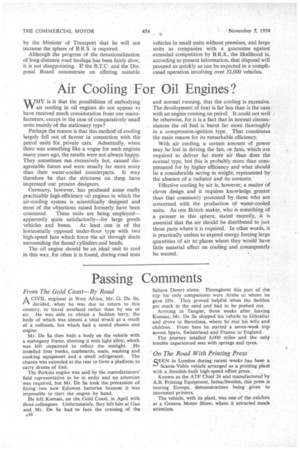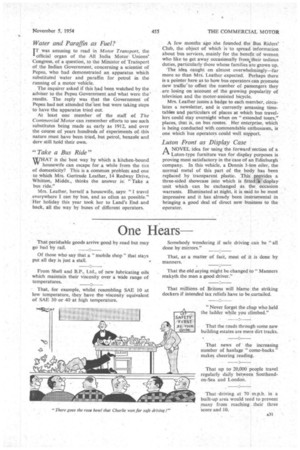Passing Comments
Page 32

Page 33

If you've noticed an error in this article please click here to report it so we can fix it.
From The Gold Coast—By Road
ACIVIL engineer in West Africa, Mr. G. De Sa, . decided, when he was due to return to this country, to travel overland rather than by sea or air. He was able to obtain a Seddon lorry, the body of which was almost a total wreck as a result of a .collision, but which had a sound chassis and engine.
Mr. De Sa then built a body on the vehicle with a mahogany frame, sheeting it with light alloy, which was left unpainted to reflect the sunlight. He installed four bunks, cupboards, seats, washing and cooking equipment and a small refrigerator. The chassis was extended at the rear to form a platform to carry ,drums of fuel.
The Perkins engine was said by the manufacturers' field representative to be in order and no attention was required, but Mr. De Sa took the precaution of fitting two new Ediswan batteries because it was impossible to start the engine by hand.
He left Kumasi, on the Gold Coast, in April with three colleagues. Unfortunately, they left him at Gao and Mr. De Sa had to face the crossing of the
A30
Sahara Desert alone. Throughout this part of the trip his only companions were Arabs to whom he gave lifts. They proved helpful when the Seddon got stuck in the sand and had to be pushed out.
Arriving in Tangier, three weeks after leaving Kumasi, Mr. De Sa shipped his vehicle to Gibraltar and drove to Barcelona, where he met his wife and children. From here he started a seven-week trip across Spain, Switzerland and France to England.
The journey totalled 6,000 miles and the only trouble experienced was with springs and tyres.
On The Road With Printing Press
3EEN in London during recent weeks has been a Scania-Vabis vehicle arranged as a printing plant with a Swedish-built high-speed offset press.
Known as the ATF Chief 24 and manufactured by A.B. Printing Equipment, Solna/Sweden, this press is touring Europe, demonstrations being given to interested printers.
The vehicle, with its plant, was one of the exhibits at a Geneva Motor Show, where it attracted much attention.
Water and Paraffin as Fuel?
1T was amusing to read in Motor Transport, the official organ of the All India Motor Unions' Congress, of a question, to the Minister of Transport of .the Indian Government, concerning a scientist of Pepsu, who had demonstrated an apparatus which substituted water and paraffin for petrol in the running of a motor vehicle.
The inquirer asked if this had been watched by the adviser to the Pepsu Government and what were the results. The reply was that the Government of Pepsu had not attended the test but were taking steps • to have the apparatus tried out.
At least one member of the staff of The Commercial Motor can remember efforts to use such substitutes being made as early as 1912, and over the course of years hundreds of experiments of this nature must have been tried, but petrol, benzole and dery still hold their own.
"Take a Bus Ride"
WHAT is the best way by which a kitchen-bound vv housewife can escape for a while from the ties of domesticity? This is a common problem and one to which Mrs. Gertrude Leather, 14 Redway Drive, Whitton, Middx., thinks the answer is: "Take a bus ride."
Mrs. Leather, herself a housewife, says: "1 travel everywhere I can by bus, and as often as possible." Her holiday this year took her to Land's End and back, all the way by buses of different operators. A few months ago she founded the Bus Riders' Club, the object of which is to spread information about bus services, mainly for the benefit of women who like to get away occasionally from, their tedious duties, particularly those whose families are grown up.
The idea caught on almost overwhelmingly—far more so than Mrs. Leather expected. Perhaps there is a pointer here as to how bus operators can promote new traffieto offset the number of passengers they are losing on account of the growing popularity of television and the motor-assisted bicycle.
Mrs. Leather issues a badge to each member, circulates a newsletter, and is currently amassing timetables and particulars of places at which bus travellers could stay overnight when on "extended tours," places, that is, on bus routes. Her enterprise, which is being conducted with commendable enthusiasm, is one which bus operators could well support.
Luton Front as Display Case
ANOVEL idea for using the forward section of a Luton-type furniture van for display purposes is proving most satisfactory in the ease of an Edinburgh company. In this vehicle, a Dennis 3-ton oiler, the normal metal of this part of the body has been replaced by transparent plastic. This provides a three-sided showcase into which is fitted a display unit which can be exchanged as the occasion warrants. Illuminated at night, it is said to be most impressive and it has already been instrumental in bringing a good deal of direct new business to the operator.




















































































































